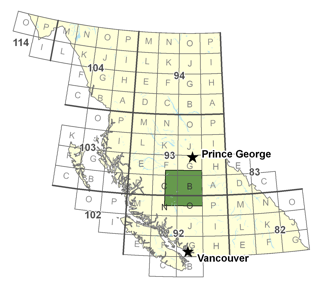Summary
 Magnetotelluric (MT) data collected in the Nechako Basin during 2007 have previously been inverted to produce 2D conductivity sections along seven profiles through the region. In the work reported here, these conductivity sections were used to assess the ability of z-axis tipper electromagnetic (ZTEM) data to determine and resolve the conductivity structure of the Nechako Basin, and to investigate the possibility of using the MT-derived conductivity sections to assist in processing the multichannel seismic reflection data collected across the basin in 2008. The results indicated that, although highly dependent on the actual conductivity structure in different parts of the basin, ZTEM data may be capable of identifying the conductive Eocene volcaniclastic rocks to shallow depths but may struggle to differentiate between the Eocene groups and the Cretaceous sedimentary rocks.
Magnetotelluric (MT) data collected in the Nechako Basin during 2007 have previously been inverted to produce 2D conductivity sections along seven profiles through the region. In the work reported here, these conductivity sections were used to assess the ability of z-axis tipper electromagnetic (ZTEM) data to determine and resolve the conductivity structure of the Nechako Basin, and to investigate the possibility of using the MT-derived conductivity sections to assist in processing the multichannel seismic reflection data collected across the basin in 2008. The results indicated that, although highly dependent on the actual conductivity structure in different parts of the basin, ZTEM data may be capable of identifying the conductive Eocene volcaniclastic rocks to shallow depths but may struggle to differentiate between the Eocene groups and the Cretaceous sedimentary rocks.Multichannel seismic reflection data were acquired along a number of profiles through the Nechako Basin in 2008. To date, processing of this data-set has proved challenging because of the complex structure of the region, with results not giving as much information about the subsurface as hoped. Here, an attempt was made to use the MT-derived 2D conductivity sections in the processing of the seismic data. The reprocessing of the seismic data resulted in sections with moderately improved reflectivity, although no new structures were revealed that had not been discernible previously. The MT-derived velocity models provided surprisingly decent starting models for the velocity analysis required for stacking the seismic data, but nothing that could not be obtained by conventional velocity analysis of the seismic data alone. Finally, work was performed to integrate the interpretations derived from the MT data with those from other existing geophysical and geological data in order to improve our understanding of the structure and formation of the Nechako Basin. The results of this integration work appear in the special section "New insights in Cordilleran Intermontane geoscience: reducing exploration risk in the mountain pine beetle-affected area, British Columbia" of the Canadian Journal of Earth Sciences (v. 48, n. 6).